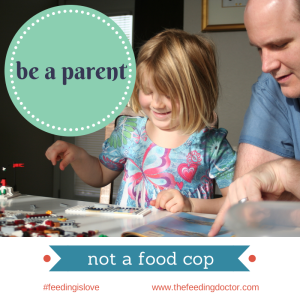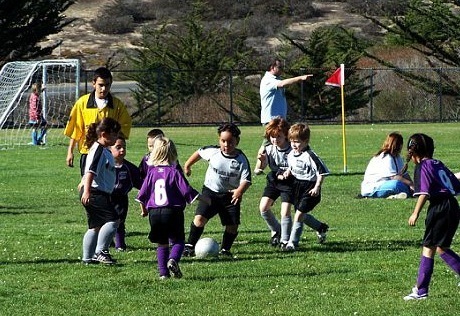Katja Rowell's Blog, page 3
January 9, 2014
Family Meal Resolutions Part II: be a parent, not a food cop
 It’s human nature. We want to continue doing what makes us feel good, and stop things that don’t. Family meals aren’t always a lot of fun, especially if there is a worry about rapid weight gain, or nutrition with a selective eater who isn’t gaining weight. When parents worry, the kitchen table is no longer a place for connection, joy and sharing time together. Rather, it becomes a place of anxiety, power struggles and counting calories or bites. This worry and focus on the child in question and how much of what she is or isn’t eating sucks the joy out of family meals, and I believe is a major reason why families give up on eating together.
It’s human nature. We want to continue doing what makes us feel good, and stop things that don’t. Family meals aren’t always a lot of fun, especially if there is a worry about rapid weight gain, or nutrition with a selective eater who isn’t gaining weight. When parents worry, the kitchen table is no longer a place for connection, joy and sharing time together. Rather, it becomes a place of anxiety, power struggles and counting calories or bites. This worry and focus on the child in question and how much of what she is or isn’t eating sucks the joy out of family meals, and I believe is a major reason why families give up on eating together.
While any medical or oral-motor or sensory issues are addressed, when I work with parents, I help them take anxiety off the table and get out of those counterproductive power struggle. When talking with colleagues who also work with children and eating struggles, what we find is that when parents express RELIEF that they no longer have to monitor and pressure, in other words when they can give up the role of food cop, things start to improve— even if there are bumps in the road.
Here are the top three tips I have seen help parents turn in that badge and begin to enjoy family meals:
Serve meals family style
Feed using the Division of Responsibility (with every meal and snack including at least one food the child is likely to enjoy)
Change your definition or “progress” to focus on attitude and connection, rather than bites or calories
Tapping into that relief and sitting with the positive feelings that now have a place at the table helps through the transition to the Division of Responsibility in feeding, when what and how much your child eats may seem worse before it gets better. One of the hallmarks of eating competent adults is a positive attitude towards food— it all starts from there.
Hang in there, and enjoy being a parent, not a food cop. Enjoy the smiles at the table. Enjoy looking forward to dinner at the end of the day, rather than dreading it.
*For a mom’s take on family style serving and changing expectations at the table, check out the Mealtime Hostage blog.
“Simply changing the way food is served significantly reduced the amount of anxiety at the table. Once he was given the option to choose what he wanted on his plate and permission to do with it whatever he wanted, family meals immediately took a turn for the better.”
Mealtime Hostage Mom-to-Mom Support Group: https://www.facebook.com/groups/MealtimeHostage/
January 2, 2014
Resolution More Family Dinner Part I: the Kitchen Island
If having more meals together as a family is your New Year’s Resolution, one often overlooked piece of the puzzle is the physical space where meals happen. Let’s consider the kitchen island. Other than just being a place to throw keys and homework, the kitchen island in many houses and apartments has replaced the kitchen table. Granite countertops sell homes— humble tables don’t.
Growing up in the 70s and 80s, most Midwestern middle class kitchens I visited did not have elaborate islands or counters with stools. I remember sitting around tables. As homes generally got bigger over the last 30 years, it seems the kitchen island became standard and the eat-in kitchen disappeared.
On house-calls or play-dates over the years, I’ve watched the parent or childcare provider standing behind the island counter preparing food and serving the children sitting at the counter. By design, the island makes line-cook and wait-staff the easiest option. And there’s nothing wrong with this on occasion. But if it always happens, it robs children of the most important mealtime ingredient—a loving adult providing company and eating from the same foods (including at least one item the child generally enjoys).
So, did form follow or dictate function? Were parents already standing and serving meals and needed a more efficient way to do so, or did the changing design of modern homes assist the slide of the communal family meal? Moms (both working and stay-at-home) are usually blamed for everything including obesity and the decreasing frequency of family meals, so I thought I’d implicate architects and home designers too.
Let’s throw in furniture designers while we’re at it, with the trend in tall dining tables with bar-stool height chairs where even the adults’ feet don’t reach the floor. What I’ve observed with these tables is the kids eating nearby at the kitchen island or on a child-sized picnic table separate from parents. Once parents and children are eating at different spaces it becomes easier (even automatic) to serve “kid” and “grown up” foods, with children missing out on the critical (no pressure) exposures to the very foods their parents want them to eat.
Islands are fine. In fact I wish I had one. A friend of mine had me over to learn how to cook some Indian dishes while her kids sat close by at the island doing homework, chatting and enjoying their after-school snack. I also think if I had an island I wouldn’t lose my keys as much, but I digress.
Making Family Meals the Easier Option
I’m no sociologist and this is not an academic post, but I think it’s worth reflecting on how our surroundings make it easier or harder for families to eat together. A popular phrase right now in public health is, “Make the healthy option the easy option.” Making family meals the easier option (it’s not really just easy) by addressing your physical surroundings may help with your goals of eating together more often.
Can you trade in that tall dining table or saw off the legs?
Can you invest in a chair that will grow with your child and provide stability and a foot rest (helps with those fidgety legs)?
Can you plan a table nook for your kitchen remodel?
Can you reserve the kitchen island for snacks and homework and use the dining table for dinner and weekend meals?
Maybe buying a desk or redoing a closet for an office space can free up the dining room table?
Can your next apartment have a dining area off the kitchen?
Can you plan on an island big enough so that everyone can eat together?
Can you sit around a coffee table on cushions if you don’t have a table?
Can you swing by an Ikea and get ideas for or find an affordable and compact kitchen table?
If you have a kitchen island, how is it used? What are other obstacles you face to making family meals happen?
December 3, 2013
Cut Kids Some Slack: Musings on Food Fears and “Helpful” Others
When M was little she had a dog phobia. I’m talking screaming, climbing on me, uncontrollable fear of even a toy poodle. I can’t count how many people tried to talk her out of her fear, usually with a dog thrust into her personal space, and often against my explicit requests for them to stop. Take the German Shepherd owner whose dog was off-leash, jumping on me while M clawed at my hair shrieking, and the owner kept smiling, “Oh, she won’t hurt you! She’s very gentle.” Well-intentioned dog owners (including friends and family) would bring dogs closer, insisting the dog wasn’t scary and everyone loved the dog, and, “Stop being so silly!” (super helpful) or, “Look, Timmy is younger than you, and he’s petting the doggie!” (Nice, throw some more shame in while you’re at it! Works every time!) I wish we could have had a sign at those times that said, “Seriously afraid of dogs. Back off. It’s not your job to get my kid over her fears…”
It is this sticker that I saw on my walk home that led to this post. If I was behind a car on a hill and it started rolling, I might get mad or honk. But with this sign (Kid Driver Manual), I know it’s a young person who is learning and I’ll be more patient. This sign reminds us to cut this kid driver some slack; have a little patience and understanding (something I strive for behind the wheel sometimes).
Of course it made me think of kids learning to eat. Imagine the selective child who only takes crackers at a party, and how us adults could all do well to remember to cut him some slack, that it’s not our job as outsiders (or parents) to make him get over his fears on our time-table, and we don’t know his history. Wouldn’t a sign make it simpler? “Kid Learning to Eat. Back Off. It’s Not Your Job to Make Me Eat.” Of course we would never do that, but it might be nice to remind adults and outsiders to MYOB. We shouldn’t have to make signs. I can dream about a world where instead of judgment and interference, the reaction to a tantrum at the grocery store, a child refusing to eat the offered food, or a child reluctant to swim at the beach, was patience, openness and kindness.
Parents of picky, selective or food avoidant kids, does the dog fear scenario sound familiar? Do others try to convince you and your child that her food fears are ‘silly,’ or she would ‘like carrots if she just tried them?’ Does it help? Does it make you mad? How does your child react?
Food fears and phobias are not something you can talk, rationalize, cajole or shame away.
Supporting children with their eating allows them to tune in to internal motivation (I want to do it) and get over their fears when they are ready. This includes (but is not limited to):
pleasant family meals with at least one safe or accepted food at every meal
no pressure, shaming, bullying or efforts to make the child eat (Division of Responsibility)
offer foods every 2-3 hours for younger kids, every 3-4 for older children
if needed, get support with anxiety from a professional away from meals and food issues
address any underlying medical problems, and consider oral-motor or sensory factors
As a sixteen year-old selective eater I interviewed for my first book, Love Me, Feed Me said, “It shouldn’t be, ‘How can I make my child eat this,’ but ‘How can I support her so she can try foods at her own pace.’” (Here is another post about a ten year-old’s A-ha moment with food.)
You never know when or what might happen that helps your child get over her fears or resistance.
Dog fear update. At about age 6, we were at a local mall and there were some very old therapy dogs laying on the ground as part of a fundraiser. Other kids were petting the dogs. M walked up to them, holding my hand and watched for awhile. Then she squatted down and started petting one grizzled, three-legged dog. From then on, I noted an increasing willingness to approach dogs, which gradually turned into petting them, at first with me asked to come with and then on her own. I made few comments, and let her run the show. Now at age 8, we own a dog, and I was amazed the other day at a local dog park when a Great Dane bounded up to us and she laughed and petted his head (almost at the same level as hers). How far we have come.
November 25, 2013
Fat and Fit. Not Fiction.
I remember literally scoffing about 10 years ago as a family doctor when I first heard you could be fit and fat. I am so glad I learned more. The quote is linked to a meta-analysis looking at ten studies on fitness and BMI. I can get behind this conclusion! Fitness was the best predictor of health, not fatness…
Why does this relate to kids? Because there is so much worry about children and weight, and all the worry leads to many parents putting kids on diets and causing far more harm than good (bigger kids and more disordered eating.) If your child’s BMI isn’t in the “normal” range, it’s not a death sentence. It’s far more complex.
Did you make a conversion from weight to health focused thinking? What helped you make that transformation? What convinced you?
Elsewhere this week on the interwebs:
Family meals, getting good sleep, decreasing stress, enjoying regular, balanced meals and moving in fun and sustainable ways leads to better health.
Mainly because I LOVE the title (publichealthrants) let me know what you think about this one about poverty and public health and feeding kids…
Still worried about fat? Another thoughtful post on why you shouldn’t fear fat from Mealtime Hostage.
October 21, 2013
African Peanut Stew/Soup, chicken recipes, and menu plan
I roasted these two ladies yesterday and have dinner planned for the rest of the week. (Easy roasted chicken recipe.) This is a slightly more ambitious meal plan than usual.
Chickens? Same time/same oven, the one on the left had crispier skin, and overcooked legs (I’m too lazy to truss properly.) I will use the chicken for the soup and enchilada casserole (making two, one for a friend.) I love the casseroles that have all the veggies in them (beans/onions for enchilada, and mushrooms/shallots/peas for tuna casserole.)
Today (synchronized swimming night) African Peanut Soup (Using some of the meat, and both ‘carcasses’ for the broth.)
Edie’s African Peanut Stew

Cook time
90 mins
Total time
1 hour 30 mins
Edie’s African Peanut Stew. Edie was a lovely dietitian and mentor before her passing. I love remembering her when I eat this stew. It is mild, but flavorful. If using left-over chicken, can prepare in 25 minutes with about 45 minutes cook time. Add an hour if starting with raw chicken.
Author: Katja Rowell, MD
Recipe type: Soup/stew
Cuisine: African influence
Serves: 6
Ingredients
1 chicken (use half for recipe, and save the other half for another dish)
1 Tbspn olive oil
1 medium red onion finely chopped (1½ cups)
1 medium green pepper (I omit this, none of us love green pepper…)
½ cup chopped carrot
½ cup chopped celery
3 garlic cloves, crushed (I used the tubes called Eden’s garden, about 3 inches)
2 Tbspn minced ginger (tube, about 2 inches)
1 Tbspn curry powder (I love Penzey’s sweet curry powder)
1 14.5 oz can diced tomatoes
1 bay leaf
1 medium sweet potato, peeled and cubed into bite sized pieces
1½ cups shelled edamame
¼ cup peanut butter (I like 365 brand regular)
¼ cup cilantro
1 5 oz bag baby spinach (or chopped kale)
½ tspn salt
1 can drained chick peas (I added this)
Instructions
In large pot, cook chicken in water (just cover chicken) and ½ tspn salt until tender about 1 hour (or use chicken from roast chicken previously cooked) Remove bone and skin, put chicken back in broth. Can add bouillon cubes to make about 4 cups of broth, or I add a carton or two of chicken broth later on.
Heat olive oil in large Dutch oven, and sautee onions, celery, carrots about 5 minutes, until glassy.
Add garlic, ginger, curry powder, stir about 30 seconds. Add tomatoes and bay leaf and any additional broth, or add broth from above back in with chicken.
Add sweet potatoes and chick peas and simmer about 30 minutes. Stir in edamame and spinach (or kale). Then stir in peanut butter. Garnish with cilantro if desired, and serve. Add more broth for soupy meal, more
WordPress Recipe Plugin by EasyRecipe
3.2.1255
Tomorrow: Tuna Noodle Casserole with grapes
Wed: Chicken enchilada casserole (with meat pulled off chicken that is frozen)
Thursday: Skillet lasagna with green beans
Friday: school Halloween party, “Taco in a bag”
What do you like to double up on with recipes? Do you have weeks where you are more ambitious than others? Are you okay with that, or do you feel ‘guilty’?
October 15, 2013
Musings on Taft’s “modern” diet
While in my hotel room, I read this article on President Taft’s modern diet…
Take a moment to read it. Listen to the language used, and the message it sends. Are you surprised by the outcome, or the conclusion? (My comments in italics below…)
“The physician spelled out exactly what Taft should eat and at what time of day. The diet included lots of lean meat, fish and vegetables without butter and gluten (wheat) biscuits, which Taft ordered from a bakery in London, Levine says. There was a list of forbidden (sugar, sweets) and permitted foods (vegetables, lean meat).”
“His weight-loss plan “seems quite similar to what we would call a low-carb diet, but people didn’t even talk about carbs at that time,” Levine says.”
Neat! Low carb diets back in the goode olde dayse…So ahead of their time!
“The interesting aspect of this paper “is how much the behavioral techniques at the time are similar to today’s techniques. The emphasis on self monitoring is there. We advise daily weighing, and food diaries are a mainstay now,” Ryan says.”
Cool! That worked so well for Taft, right? He lost 60 pounds!
He’s compliant: “you can tell from the completeness of his self-recorded weights that Taft was an adherent patient, she says. “The doctor is doing his part with frequent visits, albeit by mail, and encouragement, not scolding.”
Until he’s not...”by the time, Taft was inaugurated as president in 1909, his weight was much higher (354 pounds) than his starting weight on the diet (314 pounds)”
Shocker, research since Taft’s time tells us that most people who diet to lose weight eventually end up heavier.
No willpower!:“Ryan says Taft probably regained his weight because he went back to his old eating habits and lifestyle.”
Not biology or physiology or psychology at play here at all, no… How can these modern day clinicians and doctors ignore decades of research?
“People today may be surprised that patients were seeking care for obesity as early as the beginning of the 20th century.”
Um, what surprises me is that mainstream medicine seems to have nothing different to offer now , and that we continue to do the same thing over and over again that hasn’t worked. (Isn’t that Einstein’s definition of insanity paraphrased?)
“Levine says this article illustrates the long-standing problem of patients’ not sticking with a plan, something that still frustrates doctors, dietitians and nutritionists today, she says.”
Wow. That’s not what my take-away was. How can we continue this kind of thinking, and poor ‘treatment’ that makes the dieter less, not more healthy? If a lawyer, president of the United States who did everything he could, with every expert and chef and personal trainer couldn’t lose weight (reminds me of modern day Oprah weight saga) how can we still say it’s just about willpower, or adherence… The story is tragic, and inevitable.
added: from the NYT version of this story… About a Johns Hopkins obesity research, “She and others were also struck by Taft’s persistent hunger pangs.”
Surprised, really? Sigh all over again…
October 7, 2013
Hey Servers, Leave Those Kids Alone! (Follow up and part 2)

“The waitress came by every day, at least two or three times, talking to our daughter, making a huge deal about what a ‘great eater’ she is, how ‘good’ she is for eating all her food and cleaning her plate. My daughter just seemed so confused and didn’t say much. By day four of our trip, I was ready to scream. We’ve been working so hard on helping her with her food obsession and healing from her history of food insecurity, and trying hard to let her know that it’s okay to leave food on your plate and you don’t have to eat everything.”
This was shared with me during a recent call with an adoptive mom of a little girl who had a pretty rough start with malnutrition due to not having enough food (food insecurity), and a food obsession that is just starting to turn around with a lot of effort. I commiserated and laughed, asking if she had read my recent Huffington Post piece (coauthored with an amazing mom and colleague Katherine Zavodni MPH, RD who works in eating disorders) on the seeming trend of servers and children’s menus increasingly inserting themselves into the feeding relationship between the parent and child. It was called, perhaps too strongly worded, “Hey, Servers, Leave Those Kids Alone!” and the comments were so nasty that I had to stop reading and responding. (One accused me of making it all up.)
Among the many comments I did read, several parents and servers said it never happens and expressed incredulity (that’s putting it nicely.) I wondered if this was a regional experience? Did I only notice it because of the work I do? Did it only happen to myself and colleagues who often ask for dessert with the meal, inviting commentary? So I sent out a mini informal survey, and here is some of what we learned:
some parents never hear any comments (heaven!)
some parents get comments most of the time, and don’t mind
some parents get comments most of the time and do mind
some parents are actually asking the serving staff to get involved, to not share certain menu items, and to praise or encourage children with their eating
Here are some quotes (or skip to the end for a few ideas on how to stop or neutralize comments from servers) :
We have noticed that over the past couple of years the comments by food servers has increased. Our current “favorite” is the big high-five to Max for ordering a fruit cup.
I live in Miami, FL and even though I don’t have children, I have overheard servers commenting to other tables where there are children. Not every time, but I would say maybe 1/2 the time when we go out to eat. Mostly it’s of the “you have to eat your vegetables so you’ll grow up to be big and strong like daddy!” or “what a good girl not to want dessert so you stay skinny and pretty!”
I have had servers comment about my plate and eating. For example, if I don’t want dessert, they’ll say I’m being so good. Or if I don’t finish my vegetables they’ll make a joke about not being allowed to have dessert. I am an overweight woman, so perhaps they feel justified in commenting on my eating. I know I feel justified in calling them out on their rudeness!
I live in the rural southeast. The only comment servers ever make is asking if my kids are finished with their plate before they take it away or asking if we want a to-go box. There is one Mexican restaurant that we like and the servers always express admiration that my 6 yr. old will eat the spicy red sauce, but they are never critical of my son who does not eat it.
I live in the northeast, suburban area, and I’ve never had this happen to me.
No one has ever said that to us, but if they did they would wish they hadn’t.
We have gotten the “You’re a good eater” comment when my son eats all his food. They then comment on how skinny he is. Or, when he orders an adult size,they insist on the kids size because they assume he wont eat it all. We have also had servers automatically add fried to our son’s order, and we don’t eat them. He orders fruit instead and some servers comment “your parents must be strict.” In front of us of course.
Not too common here. Parents tend to give lots of feedback if anyone polices their parenting. I am in NY.
This trend of parents pulling aside servers to ask them to only offer the choices they want their child to have may be why some servers have started to comment, urge ‘healthy’ options, etc.
Never happened to me. But my friends have and it makes me mad.
Not sure if others have eluded to this but I think it’s also on our radar more bc we are aware of it. Also things like asking for dessert with the meal and ordering off the adult menu for kids may elicit more unsolicited feedback from servers in and of itself.
Yes – I’ve also noticed this in the twin cities. I usually use the “knowing look” approach with my kids – smile and wink at them, so they know it is a-okay.
Get comments all the time about how my 1 & 3 year old eat all their veggies and fruit and don’t like dessert… We live in the Twin Cities. Honestly, it’s nothing my husband or I have done (we just offer many types of food), it is just my kiddos preference… I cannot think of a time we haven’t gotten some commentary.
I’m from South Africa and totally amazed to hear that waitering staff make comments. You would never get that here.
What do you think? Our request in the original post to servers was this: “Parenting styles differ, and feeding styles do as well — these are personal decisions every parent makes. We simply ask, as your customers, that you allow us to make those decisions for our own families and to keep the commentary to yourself.” Is that too much to ask?
BTW, for the mom at the resort, it’s perfectly okay (even if you don’t like conflict) to leave the table and speak with a server in private. I am sure the server thought she was helping and doesn’t understand. Try something like, “I know you are trying to be kind, but we would really appreciate if you didn’t comment on what or how much our child eats. Thanks so much.” You don’t need to explain or apologize. Usually with only one meal out, it’s not worth the time and effort, but that’s up to you.
I have a whole section in my book, Love Me, Feed Me on dealing with meddlers  For waitstaff, I usually cut off comments with something like:
For waitstaff, I usually cut off comments with something like:
“We’re doing fine here..”
“Of course we ate all the broccoli, it was delicious!”
“That’s silly, we don’t have to eat all our dinner before we enjoy dessert. Could you bring it now please?”
Here is a post about family meddling. Remember that feeding with the Division of Responsibility is not the cultural norm, so it can feel like swimming against the flow! Hang in there!
September 23, 2013
School and “healthy” food rules. Have we lost our minds?
September 13, 2013
Your kids can’t be trusted— with water.
”By the time your child says he is thirsty, he is already dehydrated.”
“…need to be reminded to drink 5 to 9 ounces (10 to 18 1/2 ounce “gulps”) every 20 minutes during activity…”
“Younger children should be given water bottles with marks on the sides showing how much they should drink each time or told how many “gulps” to drink.”
“Kids’ fluid intake needs to be supervised. Children do not instinctively drink enough fluids to replace water losses, so it is essential that you watch to see how much water they actually drink”
Scary stuff. Dehydration? Heat related illness? You’re a bad mom if you are not supervising gulps…
This is the kind of thing that makes me crazy— fear and not trusting in the wisdom of the human machine. The article, which was almost exactly the info I got in a mailer from my pediatrician’s office is emblematic of how we are trained to parent from fear.
Points to ponder:
Was there an epidemic of heat-related illness?
Where’s the data to support the ounces or gulps needed?
How can they make the statement that kids don’t instinctively drink enough? How have we survived as a species unless the human body was actually very capable of managing thirst and hydration? Unless there are kidney or centrally mediated (i.e pituitary type) problems, the body is pretty great at managing this stuff.
This is the kind of statement that terrifies parents into trying to control and micromanage things we don’t need to control or micromanage. AND, if we can’t trust kids with thirst, we certainly must have to control and manage their untrustworthy hunger…
Think back to what playing outside or sports days were like for you growing up. Were you occasionally stopping by the water fountain, or enjoying a few Dixie Cups of water after a game?
Let’s imagine what actually implementing these guidelines might look like:
It’s your child’s soccer practice. You can’t trust your coach to monitor and supervise every gulp, so one adult must be there for every child. Every 20 minutes the hydration supervisor goes out on the field with a bottle that has marks on the side (or the parent can choose to count gulps but will have to sign a waiver). Then the parent refills the bottles to the correct amount. Repeat every 20 minutes. During game days, the action will stop every 20 minutes for supervised gulp breaks. Kids will be encouraged to wear “hydration alarms” that go off every 20 minutes.
If the author really believes that the child’s ability to regulate hydration and electrolyte status is that fragile, then that is what we should be doing. (And if we’re not, why aren’t legions of children passing out or overheating?)
Where is the good sense? How did any of us survive to adulthood?
Remember that there is no better consumer than a scared mom. (As an aside, notice that the second page says that sports drinks are the best choice. Wonder if sports drinks manufacturers might support and sponsor this kind of article…)
My general thoughts on hydration:
Offer milk or water with most meals and snacks
Offer water between meals and snacks.
Fruit juices: serve with meals and snacks. Try to aim for about 4 ounces for young children, more some days, less others is fine.
During activity, have water available, and allow time to drink it at reasonable intervals.
If it’s 105 degrees, maybe the kids shouldn’t be playing eight hours of soccer, or three hours of football in full gear, but that’s a personal call.
With extreme sweating/exertion and/or heat, consider electrolyte drinks or chocolate milk and water for hydration, and watch for signs of illness.
(Maybe this is a sign of changing times too. When I was little, traveling soccer and intense athletics for kids was just starting, so maybe the Dixie cup method isn’t sufficient for today’s child athletes, but is there a middle ground?)
What do you think? Is this something you see and worry about with your kids?
September 4, 2013
Are teachers or parents responsbile for teaching kids about food?
“Timmy, repeat after me: sugar is the devil.”
School is back in session. These are nervous days as many parents on my Facebook page share stories about teachers pushing kids to eat, children with food aversions being shamed and in tears, children eating in loud, crowded cafeterias with only fifteen minutes to eat etc. (Here and more school horror stories.) Then I came across this document on facebook that parents are encouraged to give to a child’s teachers. I hope my daughter’s teacher doesn’t get one.
Here’s why:
Point #2 says, “Parents (and only parents) should decide what their children eat. But that right does not extend to other people’s children… parents need to know their rights won’t be usurped by other parents or teachers offering food in class.”
Hmm, I can get behind this, particularly for younger children, and with food allergies to consider. I also agree that food shouldn’t be used as a reward, and that food (or lack thereof) may impact behavior, and that there is no need for multiple celebrations that include food of any kind.
However, things take a turn on page two. Teachers are encouraged to educate the children about choosing foods. “Help them do that by using age appropriate curricula, field trips, books and movies to discuss where food comes from, how it affects our bodies and why it all matters.” With a list of approved resources.
?
I’m confused. Only parents decide, but teachers should end-run the parents and go straight to the kids— as long as it’s approved information?
Is it not possible for informed parents (or teachers for that matter) to look at the same books, videos and resources (among others) and come to different conclusions about the relative safety (of sugar for example) and desirability of foods? What if I’ve read the books and the research and still choose to allow my child to enjoy “junk” on occasion, free from worry that I am causing harm? What if I’m convinced in fact that banning sugar and calling food “junk” may cause more harm and make children more interested/ashamed/secretive about those forbidden foods? I’m not interested in debating these issues with this post, just suggesting that educated folks can come up with different conclusions and approaches.
Furthermore, what if a family simply can’t afford the local, organic, “ethical” foods that the resources espouse? What if family food traditions differ, or a family is homeless or lives far from fresh food? How parents choose (or manage) to procure foods for their families is complex and multifactorial. Public schools must acknowledge and honor these differences.
Should a vegan teacher be free to show graphic videos (some might call propaganda) and shame children who eat meat (even grass-fed, ethically raised) or have cheese in their Bento boxes?
What about a teacher who thinks Diet Soda is healthy and lectures our children about nutrition, telling them to stop drinking milk (dairy or soy/almond/rice substitutes) since it has “too many calories?”
What if a teacher with an eating disorder raves about her new diet where she fasts for 48 hours because it is “healthy” and she read a study somewhere…
Or imagine that your tween’s track coach tries to get all the girls onto an “all natural herbal tea” for weight loss?
Teaching our children to feel good about food, meals and cooking, and their bodies is vitally important to many parents. However: that may look very different for me and my family than for the author of this document, or for your family— and don’t we all have a right as parents (isn’t it our exclusive right as the document asserts) to those different beliefs? Many of us feel upset, and protective of our children and how schools and the culture at large handles food and body image issues, but for very different reasons. As a parent, am I not allowed or entrusted to pass along my own food values, ethics, recipes and family traditions, even if they might not agree with another parent’s, or the teachers’ views?
Mealtime Hostage mom and blogger recently commented about BMI in the schools, but I think it applies: “I wish it was the case that I could send my kids to school and know that they are somewhat insulated from all the talk of fat epidemics and toxic processed snacks and all the spin on fear about not being the perfect size and eating the perfect food. Whatever happened to reading, writing and (BMI free) arithmetic?”
P.S, I would also wonder if hunger and kids skipping meals, or not having enough physical outlets isn’t as much of or more of a behavior factor than some food dye and sugar (or even HFCS!) in a tube of Yogurt for most kids… (See this amazing video from teachers about hunger.)
I’d love to hear from any teachers out there. Are you encouraged to talk or teach about nutrition? Parents, what say you? Do you want your child’s teachers chiming in on food? In what ways?
Making use of Forbidden Foods (Satter)
My post on how kids interpret wellness messages and my editorial on a middle ground
My proposed handout on talking to kids about food
5 Mistakes Parents Make When Educating Kids About Nutrition (raisehealthyeaters.com) I’d add teachers are not exempt based on my family’s experiences and those shared by our facebook community.)












